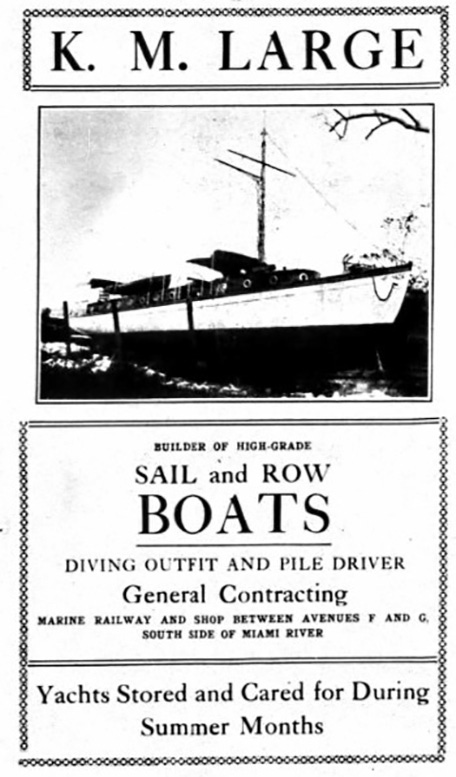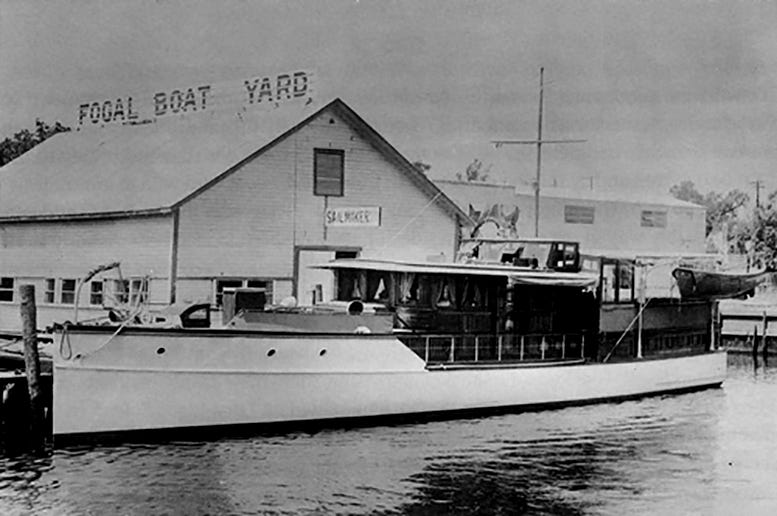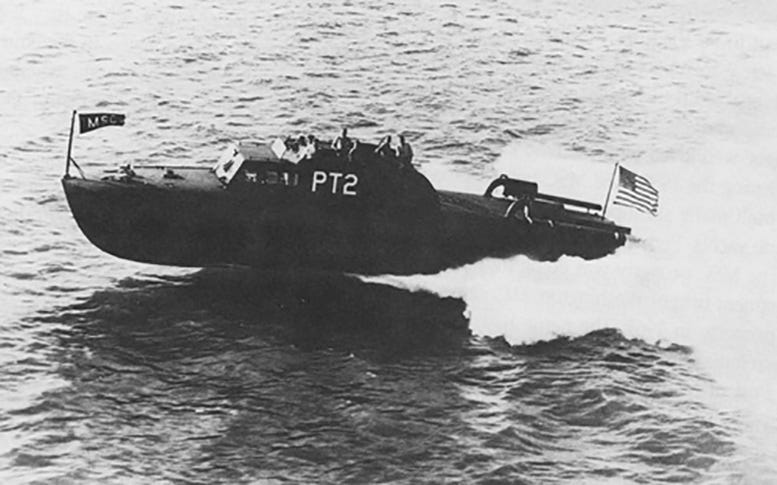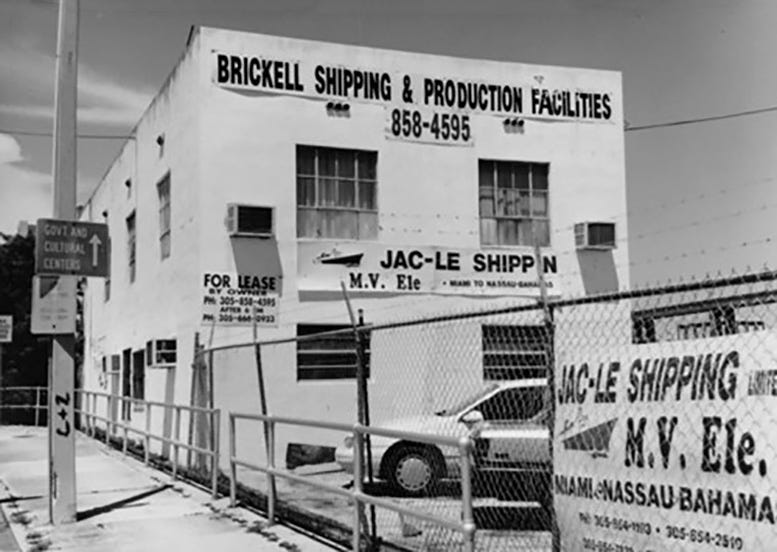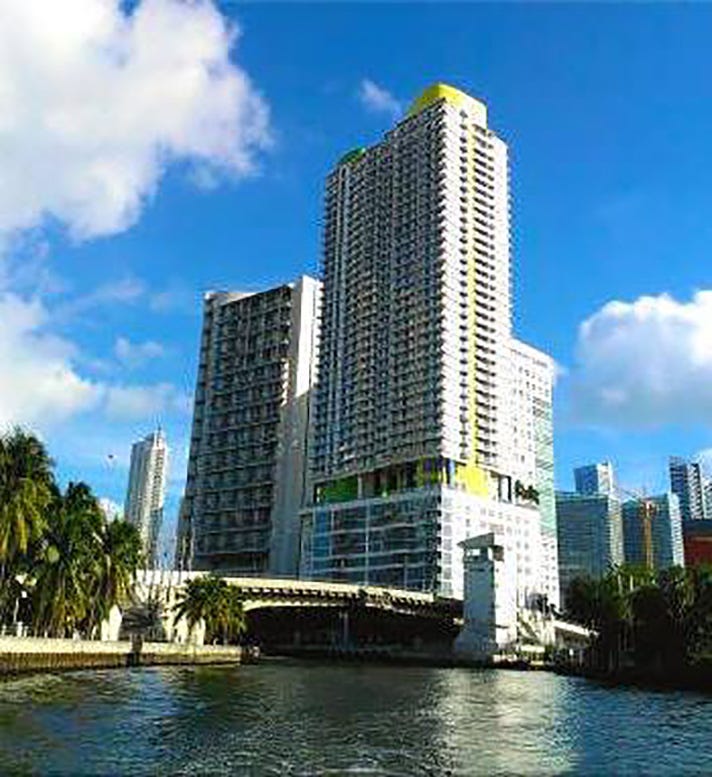Miami “Vice” Shipyard
The Miami Shipbuilding facility is probably best known for being the headquarters for Miami Vice during its run on television in the 1980s. It was the location for a boatyard from 1915 until 2000.
When the Latitude on the River office and condominium complex was completed in 2007, it began a new chapter for a parcel of land with a long and storied history. The parcel came full circle when it was once again owned by the Brickell family in 1992.
The land was utilized as a boat yard and as far back as 1896. The names of the businesses changed through the years, but the property represented nearly one hundred years of serving the maritime industry.
The Miami Shipbuilding Corporation played a pivotal role during World War II. Many years later, the property was featured as a film location for a couple of movies, commercials and the television show Miami Vice.
Early History
The first viaduct over the Miami River was the Avenue G Bridge. It is known today as the SW Second Avenue Bridge. The southernmost portion of the Miami River is located roughly around the southern terminus of this bridge. East of the Second Avenue Bridge, on the south side of the River, is the location of the Latitude on the River complex.
When the Seminole Indians traveled up the river to the Brickell Trading Post in the 1870s through 1890s, it was believed that they parked their dugout canoes along the banks of the river in this area. They would walk the short distance from this embankment to the trading post to do business with the Brickells.
According to Don Gaby in his book “The Miami River and Its Tributaries”, C.C. Cutrell started the first boat yard on this land prior to the end of 1896. The boat yard provided storage and was configured with a single marine railway (slip).
The K.M. Large Company operated the boat yard from 1906 through 1920. According to Gaby, Captain S. Gedney purchased the business in 1911. However, the Miami City Directory and advertisements in the Miami Herald indicate that Captain Kenneth M. Large operated the business at least until 1920. He was listed as a boat builder and boat yard operator.
Captain Gedney was the brother in law of a man who arrived to Miami in 1917. Morton Fogal was a New Yorker who came from a family of boat builders and boat yard operators. However, Fogal wasn’t listed in this vocation in Miami until 1921.
Fogal Boat Yard
When Morton S. Fogal first arrived in Miami in 1917, he was listed as an awning maker. His business address was a couple of blocks from the boat yard at 2116 Avenue F in today’s Brickell neighborhood. This was located roughly at SW First Avenue and Ninth Street, about a block west of The Shops of Mary Brickell Village.
In 1919, he moved his business and shared space with the K.M. Large Company along the Miami River. The next year, he was listed at the northeast corner of today’s SW Seventh Street and SE Second Avenue. This later became the location of the Art Moderne style office building at 615 SW Second Avenue built by the Miami Shipbuilding Corporation.
It was in 1920 that Fogal took over the boat building business. The 1921 Miami City Directory listed Kenneth Large as a boat captain at a different address. He didn’t appear to be affiliated with the boat yard by this time.
It was 1921 when Morton Fogal began operating the business as the Fogal Boat Yard. Shortly after taking over the business, the city platted Southwest Sixth Street right through one of Fogal’s concrete buildings and a couple of his marine railways.
However, Morton was not deterred. In the winter, he catered to visiting yachtsmen. In the summer, he repaired commercial vessels, and built yachts for northerners in preparation for the following winter season. Fogal employed forty men during the peak of business. He was very proud to advertise that he was willing to build any size boat.
The business grew rapidly during the 1920s as there was a big demand for high speed boats during prohibition. It was said that Fogal built powerful boats for rum-runners side-by-side with similar boats for the coast guard.
His business continued to expand and grow in the 1930s. However, Morton Fogal died of heart failure on November 15, 1935 in his home at 733 Alhambra Circle in Coral Gables. The home, built in 1925, still stands today.
After Morton’s untimely death, his widow sold the business to a New York family.
Miami Shipbuilding Corporation
Along with his three sons, Emil Buhler bought the Fogal Boat Yard in December of 1935. The family continued operation under the name of the “Fogal Boat Yard” for a few more years. They also continued to grow the business.
In 1937, the Buhler’s built a large marine railway (slip) that could accommodate 750 tons. The railway was built at an angle to the river on the west side of the property near the SW Second Avenue Bridge. Later, they built another railway on the east side of the property.
The late 1930s brought a lot of opportunity and growth for the boat yard. In 1939, the company changed their name to the Miami Shipbuilding Corporation (MSC). In the same year, the company was given news of the award of an important government contract.
PT boat Contract
In preparation for being pulled into the fight against the Nazis, the US Navy issued a bid to build nimble but powerful fast attack boats to support the eventual war effort. The MSC submitted a response and won the first contract to build two models of Patrol Torpedo (PT), boats.
The PT-1 and PT-2 models were powerful fifty nine foot boats. The PT boats was a torpedo armed fast attack craft that would play a pivotal role in World War II.
However, given delays in the shipment of the “Vimalert” engines by the government, the contract could not be fulfilled until the war was well under way. The delay in receipt of the engines proved fortuitous. It gave the MSC the opportunity to design the sixty three foot Air Rescue Boat (ARB). The boat was built to rescue downed pilots.
Powered by a 650 horsepower engine, the ARB was faster than the PT boats. MSC ended up building and selling 327 ARBs during the war for the U.S. and various other foreign governments. MSC became so adept at building the ARB that they were able to build them in just eighteen days from start to finish.
During the war, the shipyard was also used to convert pleasure boats, donated by their owners for the war effort, for use by the U.S. Navy and Coast Guard. These were boats that ranged in size from 38 to 170 feet in length.
The war contracts required MSC to expand beyond their Miami River location. For a couple of years, they used land on the north side of the river to help with boat construction. They also operated a marina in Coconut Grove that is now the location of Monty’s. They ran the Seaboard Lumber Yard in Coral Gables to ensure they had the materials to deliver on the contracts they were awarded.
At the peak of their business, MSC employed 1800 people. The MSC was able to produce one boat per day at the peak of production in 1943. Their rate of delivery was so important to the war effort that they were awarded the highest rating for wartime production by both the Army and Navy. It was during the peak that MSC began an expansion and reconfiguration of their main location on the river.
Expansion of Early 1940s
It was during the expansion of the early 1940s that most of the original buildings of the Fogal Boat Yards were demolished and replaced. The construction sheds and winch houses were modernized. The 300 ton transfer system was upgraded. It was considered one of the largest transfer systems of its era.
During the expansion, MSC built two new administrative buildings. The main building was built in an Art Moderne architectural style and was completed in 1942.
One of its distinctive features was a Bas Relief over the main entrance of the building. The large relief panel showed a man holding a ship aloft while kneeling in water and surrounded by the ship's helm, propeller and gear. The main entrance faced northwest on SW Second Avenue.
Some of the other buildings that were erected during the expansion included a machine shop, construction shed, new winch houses and the office / lavatory building which was constructed just north of the main administrative building.
Also during the expansion, SW 6th Street was closed off and the yard was extended southward. The change in the street configuration partly explains the break in SW 6th Street from South Miami Avenue to SW Second Avenue.
Post War & Bankruptcy
Although the war provided a boom for the Miami Shipbuilding Corporation, one month following the conclusion of the war, the company fell into receivership. It remained in this state until November of 1948 when Loomis and Paul Buehler were given back control of the company.
The brothers cited slow post-war demand for pleasure boat construction as one of the reasons for their financial difficulties. The company’s production capacity had grown quickly during the war, but was overkill for private sector demand after the war.
In the 1950s, the company helped pioneer the design and manufacturer of Hydrofoils. This technology provided a lift above the water surface to help decrease drag and allow boats to travel at a greater speed.
The company also built many shrimpers and promoted the “trawler hull” design prior to it becoming popular in private yachts. It was said that the company was well ahead of its time. Being ahead of the trends had its impact on the bottom line. It led the company to bankruptcy in 1960.
The MSC was purchased by a real estate investment firm from Washington, DC as it teetered on bankruptcy. The firm was represented by James W Brown. In 1965, the company’s name changed to the Miami Shipyards. It was during this time that Brown came down to Miami, with the intention to sell the property when he saw an opportunity.
Brown had learned that the Dade Drydock Company intended to leave the area. Given the change in competitive landscape, he felt there was plenty of opportunity to run a viable shipyard in Miami.
Initially, the company grew their business by servicing island boats, such as Bahamian freighters, and then expanded by servicing large Coast Guard cutters. By the 1970s, Brown had the company back on a profitable track repairing yachts and barges.
It was during the operation as the Miami Shipyards that the company gained notoriety from a very popular television show. The front façade of the Art Deco administrative building was cast in a recurring role on Miami Vice.
Featured in TV Shows & Movies
By 1984, the aging white Art Deco building along SW Second Avenue was over forty years of age. It got a lift when the television producers of Miami Vice thought it would make for a great headquarters for the show’s Organized Crime Bureau (OCB).
It was represented as a confidential location with a fictional company name on the outside. The company name that provided cover for the OCB was “Gold Coast Shipping”.
In addition to the cameo appearance of the front façade, the shipyards served as a shoot location for the show during their five year run on television. The inside scenes were filmed in a studio located in North Dade. The property appeared in several episodes of season one in 1984.
In 1991, the Miami Shipyards buildings appear briefly in a scene from the John Travolta movie “Chains of Gold”. During a scene when Travolta’s character raced a car over the Second Avenue Bridge, the main administrative building appeared in the background.
In 1994, it was a primary shoot location for the Sylvester Stallone’s movie “The Specialist”. The production crew built a wooden prop building on the property to act as the main character’s hideout. The temporary structure was located on the north side of the property near the main building.
The hideout was an important location during the climatic scenes during the conclusion of the movie. The prop building was blown up at the end of the movie.
Also, as part of the filming of “Bad Boys” in 1995, the back of the property can be seen from across the Miami River in one scene. Burn Notice paid homage to Miami Vice by featuring an aerial transition shot over the Latitude on the River buildings during several episodes in the late 2000s.
The property had plenty of cameo appearances on both the big and little screen from 1984 through the 2000s. It would also experience a change of ownership during this same timeframe.
Brickell Shipping Company
By the early 1990s, a recession had dealt the boating industry a big setback. In January of 1993, James Brown decided to shut down the Miami Shipyard Corporation. In a Miami Herald article, he said “I tried to keep her afloat, but lease problems, real estate taxes and, above all, continued demands of various governmental agencies involving the environment and pollution made it uneconomical to keep going”.
A year prior to this announcement, Marjorie and Butch Brickell purchased the parcel of land that was once owned by the Brickell family prior to 1896. Following the closure of the Miami Shipyards, the Brickells took over the property and opened the Brickell Shipping Company.
Marjorie was the widow of William Brickell II and Butch was the couple’s only child.
During the time Marjorie and Butch started the shipping company, production studios were reaching out to Butch to use the property as a film location for movies and commercials. Butch converted one of the buildings into a production facility.
Prior to going into the cargo business, Butch Brickell worked in the family’s property management business. He later became an actor and stunt man. He got his first job as a stunt man in “The Specialist” in 1994.
From that point forward, whenever any television or movie productions would come to town, Butch was hired to be a stunt man. In addition to “The Specialist”, he was cast in this role in the movies “2 Fast 2 Furious” and “Bad Boys”. He was mostly asked to be a driver in high speed chase scenes.
In July of 1998, the ship yard was in the news for different reasons. U.S. Customs agents seized 798 kilos of cocaine, with a market value of $13.5 million, in the aft ballast of the Belize registered vessel, Nina-N. The ship was docked at Brickell Shipping when the bust occurred.
The Brickell’s operated their businesses until the early 2000s. Butch Brickell died in 2003 from an accidental overdose of pain killers. The end of the Brickell Shipping Company marked the beginning of the end for the buildings located on the shipyard property.
Latitude on the River
In 2000, Janus Research was hired by the Florida Department of Transportation to provide a historical documentation survey of the buildings that comprised the former Miami Shipyards Corporation. This survey was conducted as part of the project to replace the SW Second Avenue Bridge.
The survey noted that the only building associated with the complex that was considered to be a significant historic resource was the Art Moderne administration building. All the other buildings in the yard were considered noncontributing resources.
Although the main building had plenty of history, there didn’t seem to be much interest in protecting it. While the Art Moderne administrative building is listed on the Historic Preservation District web site, it never received historic designation protection.
When the replacement SW Second Avenue Bridge was completed in 2003, the Art Moderne building was no longer visible at street level. The new bridge was built with a much higher elevation than the prior bridge, and the grade changed the street level for buildings on both sides of SW Second Avenue.
In November 2003, it was announced that Miami developer J. Kevin Reilly had partnered with Boston-based EA Fish Associates to build what is now the Latitude on the River complex. The complex consists of two buildings: condominium and office. The buildings were designed by Architectonica.
The Art Moderne administrative building was razed in 2004. The Latitude on the River complex was completed and opened in 2007.
While the new project required the demolition of the Art Moderne building, the partners agreed to save as much as they could from the Bas Relief panel, as well as, replicate the entrance and place it at the corner of SW Seventh Street and SW Second Avenue. In addition, there was a suggestion to provide a historic marker along the river recognizing the role that the Miami Shipbuilding Corporation served during World War II.
However, to this day, there is no recognition of the historic significance of the parcel of land anywhere on the Latitude on the River complex. While there was no contractual agreement to do what was promised or suggested, it is a shame that a parcel of land with so much history has no evidence of its importance to Miami’s past.
Special thanks to Dr. Paul George for providing his assistance with the research of this article.
Resources:
Book: “The Miami River and Its Tributaries” by Donald C Gaby (1993)
Book: “The Magic City captured by Miami Vice, Scarface, Movies, and Burn Notice”, by Col. James C. Staubach (2016)
Survey: “Historical Documentation Survey of the Miami Shipbuilding Corporation Office / Lavatory Building”, Janus Research of Saint Petersburgh and Coral Gables. Courtesy of HistoryMiami.
Miami Herald: “Heat Disease Fatal to Morton S Fogal”, November 24, 1935.
Miami Herald: “Boat Yard Sold to New Yorker”, December 26, 1935.
Miami Herald: “400 New Jobs Loom in Miami”, October 4, 1940.
Miami Herald: “Miami Vessels Prove Worth”, August 9, 1942.
Miami Herald: “Ship Workers Await Awards”, August 10,, 1942
Miami Herald: “Buhlers Regain Control of Shipbuilding Firm”, November 26, 1942.
Miami Herald: “Office Building Finds Fame as Miami Vice Site”, November 14, 1985.
Miami Herald: “Historic Miami River Shipyard Closing Down”, January 11, 1993.
Miami Herald: “$13.5 Million Cocaine Seized”, July 22, 1998.
South Florida Business Journal: “Former TV Cop Station to Yield 42-Story Tower on River”, November 10, 2003.
Images:
Cover: Miami Shipbuilding Corporation Administrative Building in 1943. Courtesy of HistoryMiami.
Figure 1: KM Large Boat Yard Ad in 1915. Courtesy of Miami Herald.
Figure 2: Fogal Boat Yard in 1937. Courtesy of HistoryMiami.
Figure 3: PT-2 sea trial near Miami Beach in 1942. Courtesy of HistoryMiami.
Figure 4: Aerial of MSC property in 1941. Courtesy of HistoryMiami.
Figure 5: Art Moderne Building in 1942. Courtesy of Florida Memory.
Figure 6: Aerial of Miami Shipbuilding Corp property in 1942. Courtesy of HistoryMiami.
Figure 7: Boat built at MSC in 1958. Courtesy of HistoryMiami.
Figure 8: Miami Vice OCB HQ in 1984. Courtesy of Miami Vice Television Show.
Figure 9: Brickell Shipping in 2000. Courtesy of HistoryMiami.
Figure 10: Latitude on the River. Courtesy of Latitude on the River.



